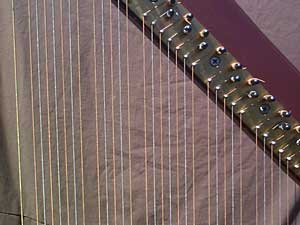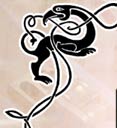The in-line chromatic harp (or single row chromatic harp) was born out of the need for a fully chromatic harp without pedals and without levers. It was designed to be simple to play. The in-line chromatic harp is simpler to play than the cross strung chromatic harp and other chromatic harps such as the triple harp, arpa doppia, etc. It only has one rank of strings, just like the diatonic harp and strings can be plucked in a normal 1234 4321 sequence just like any other pedal harp or folk harp. For those of you who are not familiar with the cross strung chromatic harp, the sequence of strings to be plucked is often altered in the latter to accommodate the string crossing configuration. With the in-line chromatic harp this problem is avoided.
The harp is played in a manner similar to that of an ordinary folk harp.

The only differences are:
1- whereas diatonic strings (white keys on the piano, bronze strings on this harp) are equidistant, just like on a folk harp or pedal harp,.... one can find all the sharps (on this harp: silver strings;black keys on the piano) in between these strings. Sharps are indeed positioned as on a piano...in between the "white keys" in the following sequence:
E FF#GG#AA#B CC#DD#E ...etc
I believe that in this type of distribution where all white keys are equidistant and sharps are in between make playing easy. The player can easily "see" the notes. Diatonic strings are where they normally are on a harp or keyboard instrument and sharps likewise. The spaces between B-C E-F and colour coding of the sharps make note identification as simple as it is on a piano.
2-Because of the short spacing (about 5 /16th") between diatonic and sharp strings this instrument is only suitable for finger-nail plucking in a technique reminiscent of wire harp playing or guitar playing.. The prototype is currently strung with acoustic guitar wound strings, but there is no reason why nylon strings or plain bronze strings should not work, provided that the harp would be designed for it. The octave spacing (as in E to E) is about 4 3/8" everywhere.
The in-line chromatic harp, I believe, dates back to the Renaissance (although there is no formal historical evidence of this). One can find oblique references to single rank harps being strung with 12 string octaves (instead of 7) either over the whole stringband or partially, but no one knows for sure. In any event, I do not consider that any contemporary maker could possibly call the in-line chromatic configuration his invention...these harps belonged to our forefathers and now they belong to the harping community. Our only merit, perhaps, would be to build them again and to promote them among the harping community.
The prototype on the pictures is a 3 octave E2-E5 (37 strings) instrument being sold in 1999 at the price of 2500 US $. A 4 octave C2-C6 will also be available in the near future.







